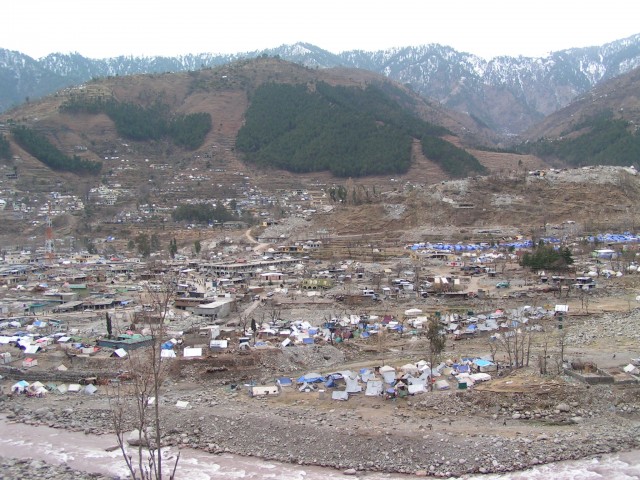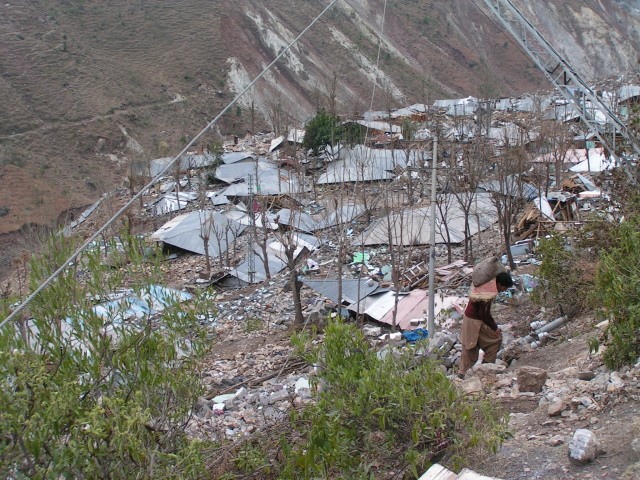20 December 2011
No! No! No! Misconceptions about seismic hazard in Kashmir (and what the literature said about earthquake hazard in Haiti)
Posted by Dave Petley
![]() One of the stories that emerged from the AGU Fall Meeting was this report about the potential for a further large earthquake in the Kashmir region of the Himalayas. This is work by the eminent seismologist Roger Bilham warning that Kashmir remains a region of high seismic hazard. The news reports, of which there were several, was based on a paper presented at the AGU Fall Meeting, for which the abstract is as follows:
One of the stories that emerged from the AGU Fall Meeting was this report about the potential for a further large earthquake in the Kashmir region of the Himalayas. This is work by the eminent seismologist Roger Bilham warning that Kashmir remains a region of high seismic hazard. The news reports, of which there were several, was based on a paper presented at the AGU Fall Meeting, for which the abstract is as follows:
| ABSTRACT ID: T54B-06 |
| TITLE: Velocity Field in the NW Himalayan Syntaxis: Implications for Future Seismicity |
| SESSION TYPE: Oral |
| SESSION TITLE: T54B. Earthquake Geology and Seismotectonics in South and East Asia IV |
| AUTHORS (FIRST NAME, LAST NAME): Roger G Bilham1, Walter Szeliga1, Bikram Singh Bali2, Asif Khan3, Abdul Wahab3, Faisal Khan3, Sufyan Qazi3 |
For the past eight years we have monitored crustal deformation in Ladakh, the Karakoram, Kohistan, Zanskar, Salt Range and Pir Pinjal, using a combination of fixed and campaign GPS measurements, to provide quantitative constraints on the rates of convergence in the NW syntaxis of the Himalaya. We find a 13-17 mm convergence rate with maximum SSW velocity gradients NE of the Kashmir Valley beneath the Zanskar range, and maximum SSE directed gradients NW of the Peshawar basin beneath the Kohistan range.
The inferred locking line appear to follow the 3.5 km contour as it does elsewhere in the Himalaya, however, this results in a 200 km wide décollement, twice the width of the central Himalaya. The SSE velocity of the Potwar Plateau is 3 mm/yr, significantly slower than the 6-12 mm/yr inferred from geological offsets along the Kalabagh fault in the past 10 My, and hence an inferred slip deficit exists between the Kohistan Range and the Salt Range. No great earthquakes are known in this area, and it is unclear whether the deficit is annulled by accelerated salt-decollement creep or by seismic rupture. A brief period of accelerated creep followed the 2005 Kashmir earthquake.
Velocities across the Kashmir Valley and Pir Pinjal are suggestive of a locked décollement (no creep) implying possible SE translation of the entire Kashmir Valley in great earthquakes. Were the segment of the Himalaya between the 2005 Kashmir Earthquake, and the Mw7.8 Kangra earthquake to slip 20 m in a single earthquake, it could do so in a Mw=9. No earthquake of this severity is known, although the historical record includes several earthquakes that may account for partial slip of the decollement. Slip on the Reasi fault north of the frontal Pir Pinjal range front can account for less than half the observed convergence at this longitude, and although no surface slip has been detected in the ranges fronting the Punjab plains, we deduce that the frontal folds, and associated blind thrusts, may absorb convergence of 5-9 mm/yr.
Note a few things here. First, this is based on geodetic measurement – i.e. real data. Second, the abstract says (my emphasis): “were the segment of the Himalaya…to slip in a single earthquake, it could do so in a MW=9.”.
In the article linkled to above, this is translated into a quite measured piece about the potential for a large earthquake, and the likely consequences of such an event. This earthquake risk is very real, and urgently needs addressing through preparedness and measures such as improved building codes. This is not an issue that can be ducked.
Today, two Pakistan newspapers (here and here) are reporting a response from “the director of the Pakistan Meteorological Department, Director General Arif Mehmood that seeks to “downplay” the fears. The longer of the two articles has a report of an interview with the Director General, including a direct quote from him (note both articles have essentially the same take on this topic):
“Talking to this scribe PMD Director General Arif Mehmood played down the findings about any major earthquake in the Kashmir region and said the recent earthquake in Haiti is a grim and embarrassing reminder that seismologists cannot predict earthquakes.
He said if anyone predicts major earthquake anywhere in the world it means he tries to over-simplify a much complicated issue because there is no evidence in the recorded history that anyone was able to rightly predict any earthquake before its occurrence. “The researchers have been doing hectic work and may be sometime in future we are able to rightly predict earthquakes but at the moment I am not ready to believe any such prediction because no science or methodology is yet available to do so,” he said.”
So where does one start with this stuff? Well, note that the Director General builds a strawman argument: “recent earthquake in Haiti is a grim and embarrassing reminder that seismologists cannot predict earthquakes”. Correct! However, Professor Bilham did not predict an earthquake – and indeed nor would he try. What he has done is to measure strain patterns, which are an indication of earthquake potential, and thus has estimated seismic hazard. And indeed Haiti provides a chilling warning to Kashmir, as two years before the earthquake Manaker et al. (2008) wrote:
“Similarly, the Enriquillo fault in Haiti is currently capable of a M(w)7.2 earthquake if the entire elastic strain accumulated since the last major earthquake was released in a single event today”
This was not a prediction of an earthquake, but geodetic measurements being used to highlight seismic hazard. Note that the earthquake that occurred in 2010 was Mw=7.0, although it is now thought that it occurred on a different (parallel) fault system. So, this “downplaying” of the warning from Bilham is based on an entirely false premise.
In the aftermath of the 2005 Kashmir earthquake I visited the area twice. So I finish this post with two pictures that I took of the aftermath of the earthquake. It is this that we are trying to prevent here . Rejection of legitimate, science-based warnings of seismic hazard do the population of potentially affected areas a huge disservice:
Reference:
Manaker, D., Calais, E., Freed, A., Ali, S., Przybylski, P., Mattioli, G., Jansma, P., Prépetit, C., & de Chabalier, J. (2008). Interseismic Plate coupling and strain partitioning in the Northeastern Caribbean Geophysical Journal International, 174 (3), 889-903 DOI: 10.1111/j.1365-246X.2008.03819.x




 Dave Petley is the Vice-Chancellor of the University of Hull in the United Kingdom. His blog provides commentary and analysis of landslide events occurring worldwide, including the landslides themselves, latest research, and conferences and meetings.
Dave Petley is the Vice-Chancellor of the University of Hull in the United Kingdom. His blog provides commentary and analysis of landslide events occurring worldwide, including the landslides themselves, latest research, and conferences and meetings.
He is not a “General”. Instead, his designation is “Director General”. I think there is some confusion.
[Thanks – now corrected. D.]
Having said that, let’s not rely very heavily on the capacities of the folk at Pak Met.
The issue needs to be highlighted at all levels, coz that’s how they are able to hear it loud and clear.
First of all DG Met is not a Geologist. I am pretty sure; he is not familiar with Geodesy and how it works.
Moreover he doesn’t know Dr. Bilham and his research in Himalayas in the past two decades.
Unfortunately, Pakistan metrological department is dealing with this stuff. This issue needs to be highlighted by Geological survey of Pakistan or by any university department of Geological Sciences of Pakisatn.
We people in Pakistan has a conventional style( non-progressive style) of research. We should confess about the discrepancies we have in our system. Our system does not allow to do free style of research. So, it becomes impossible for our Pakistan-based institutional researchers to provide scientifically oriented results. Same is the case with this devastating Kashmir earthquake. Here politically biased decisions does not make the things fruitful for the public.
Very interesting post. Will bring up in my Natural Disasters course. Thanks.
If kashmiri folks thinks that it will be a dangerous thing for our next generation so in my thinking they are all crazy
Kashmir is highly seismic zone n tectonically active, so anytime hare would b hazard.
[…] underestimated. In detail, he raised concerns about a possible M8.7 EQ in the Kashmir region. Read this great and enthusiastic article by Dave Petley on this topic. Secondly, Bilham published an article on the past and future seismic […]